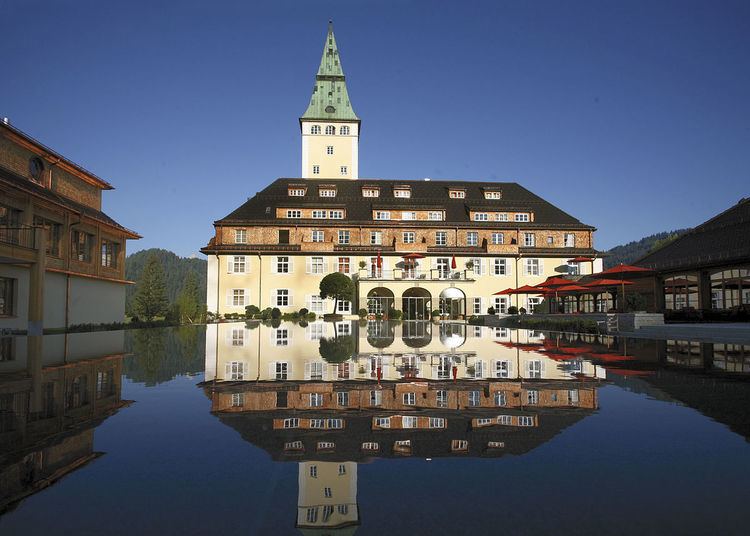 | ||
Schloss Elmau, built by Carl Sattler in the style of Reformarchitektur during WW1 between 1914 and 1916, is a two-story listed monument with hipped roof, tower and porch, situated between Garmisch-Partenkirchen and Mittenwald in Bavaria, Germany. It lies at the foot of the Wetterstein mountains in a Naturschutzgebiet (nature reserve), belonging to the Krün municipality.
Contents
Early history
The land was purchased in 1912 by the Lutheran theologian Johannes Müller (1864-1949), brother-in-law of Carl Sattler, who wrote articles now widely considered as Anti-Judaism. Prince Maximilian of Baden, Reichskanzler in 1918, and the Lutheran theologian Adolf von Harnack were close friends. Financier of the building was Elsa Gräfin Waldersee, née Haniel (Unternehmerfamilie). There were eleven children, thereunder Ingrid, Bernhard and Sieglinde.
Since 1942 Ducci Mesirca, husband of Ingrid Müller, managed the combination of convent, sanatorium and youth hostel, which was originally intended to be an artistic community where 'Helpers' (not employees) cared for visiting guests and artists; well known for its Elmauer dancing party with quadrille and Otto Ludwig (pianist). The 'Helper' scheme enabled thousands of young people from around the world to gain independence and work experience in a fabulous natural environment, while being inspired by interaction with world-famous artists of all genres.
During the Nazi era, Müller avoided the risk of an expropriation order by leasing the building to the Wehrmacht. Troops used the site for rest and recuperation after battle. After WW2 Johannes Müller was condemned as a war criminal (Hauptschuldiger) because of supporting Hitler in his articles (Spruchkammer). As a result, he lost his property. The castle was then briefly confiscated by the U.S. Army and used as a field hospital. The Bavarian government used the building as a ward for Displaced Persons, survivors of the Holocaust and for tuberculosis patients. After Johannes Müller died in 1951, Bernhard and Sieglinde Müller leased the castle from the government to run it in the old tradition. Sieglinde Müller and Mesirca get married in 1954.
Take over by Dietmar Müller-Elmau
After selling his company Fidelio to MICROS Systems Dietmar Müller-Elmau, son of Bernhard, leased the building and started running exclusive wellness-tourism for the wealthy. Gradually, however, the 'Helper' scheme, and Elmauer dancing parties ceased and its working practices are now not far removed from any other exclusive hotel.
The tradition of inviting world-renowned artists, particularly musicians, to perform at Elmau has continued. Cellist Sol Gabetta, clarinettist Sabine Meyer, and conductor Gidon Kremer appear regularly, and over the years such legendary musicians as violinist Yehudi Menuhin, soprano Barbara Hendricks, and pianist Mitsuko Uchida have headlined evening concerts. The jazz piano player Vladislav Sendecki recorded there his 'Solo piano at Schloss Elmau' in January 2010.
In the early hours of 7 August 2005 a fire broke out in the Schloss, caused by a faulty electric blanket belonging to the former manager, Ducci Mesirca. The fire destroyed nearly the entire top floor of the main building, although there were no serious casualties. The hotel has since been rebuilt.
The five-star hotel today offers 123 rooms and suites, as well as a concert hall and several restaurants. It is a forum for renowned international conferences and meetings. It is a member hotel of The Leading Hotels of the World.
G7 Summit
Schloss Elmau was the site of the 41st G7 summit on June 7–8 2015, which the German government announced on January 23 2014.
